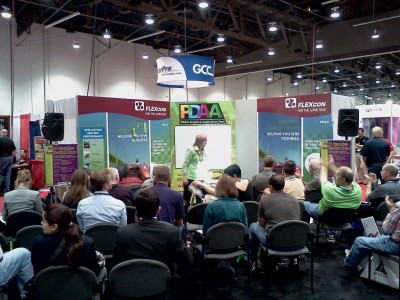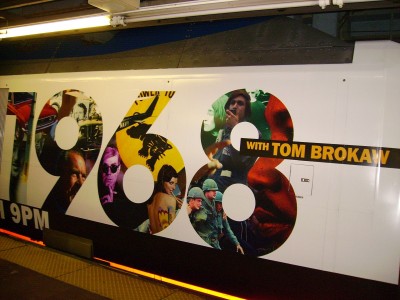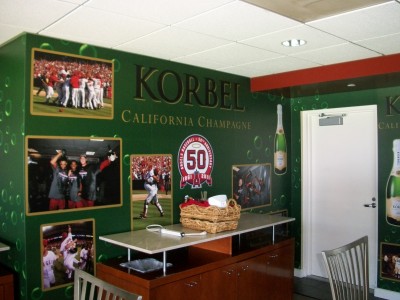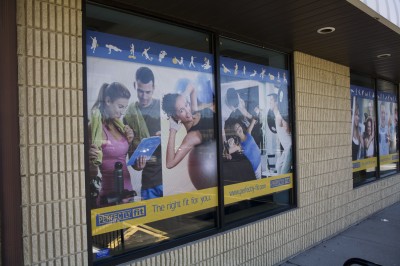Graphic Wraps: Covering surfaces with images
by all | 3 April 2013 8:30 am
 [1]
[1]Photos courtesy Flexcon
By Jodi Sawyer
At the most recent Specialty Graphic Imaging Association (SGIA) Expo, which took place in October 2012 in Las Vegas, Nev., the Professional Decal Application Alliance (PDAA) delivered a number of educational and networking opportunities for wide-format printing professionals, graphic installers and product manufacturers. Hands-on demonstrations and open discussions fostered collaboration and learning, as specialists shared their day-to-day successes, lessons about expanding into new markets and how to help advertising agencies and brand managers better engage their customers.
The PDAA’s own master certified installers demonstrated wrapping and other graphic application methods using wide-format media. Presentations covered walls, windows, counters and other surfaces, while also addressing market trends, new materials and application challenges and solutions, with a focus on educating both printing and installation communities, as well as clients.
 [2]
[2]At the 2012 SGIA Expo, PDAA’s zone featured educational presentations about wall, window and counter graphics, among other applications.
Floor, carpet and counter graphics
Floor graphics have been used in the retail sector for years to help shoppers find products on shelves or to direct their attention to special merchandising promotions. Studies have shown they typically result in a seven to 16 per cent sales lift.
Recently, the sign industry has seen a plethora of new options to enhance these ads. Clear materials, for example, allow the existing floor surface to become part of the design and provide a greater sense of dimension.
There are also thin-gauge full-coverage materials in clear, white, opaque, silver or brushed-silver variations to visually transform an entire store aisle, taking the shopper-engagement experience to a new level. In addition to branding elements, these films can use printed textures to create environmental effects, like grass, wood, rocks and water.
In high-traffic carpeted areas, on the other hand, new durable overlaminates are helping carpet graphics resist heel punctures, reduce lifting and delivery improved clarity compared to the thinner-gauged overlaminates.
Floor graphic materials can also now better match the look and feel of the products they are advertising, extending a continuity of branding from the store shelves. Metallic graphics, for example, can provide the same appearance that is becoming common in packaging effects printing, such as on beer cases.
Retail stores and restaurants often use counter graphics, too, as a resource for customers, displaying new promotions and product information. These decals can help boost impulse purchases, as customers at the checkout counter are suddenly aware or reminded of a product they could use or simply forgot to pick up.
With today’s films, counter graphics can offer both esthetic and functional performance. They appear sharp and crisp for close viewing, remain durable and abrasion-resistant for the span of an advertising campaign and are easily removed and changed out regularly as new promotions come along. This combination of traits has become important for quick-service restaurants (QSRs), many of which are increasingly turning to counter graphics to highlight newly introduced products right in front of their customers, whether specific to one location or as part of a national or international campaign.
There are specialty films that offer prismatic effects to capture customers’ attention and non-adhesive ‘grippers’—with clear or black laminates—for a distinctive look and feel. And there are more films available today that look and feel like polyvinyl chloride (PVC), but entail a smaller carbon footprint, with less negative impact on the environment.
Wall graphics
Walls are prime real estate for promotional graphics, yet are often neglected. They can be used for mural-sized advertising, branding and promotion or merely as one part of a retail environment’s visual impact.
 [3]
[3]Walls are prime real estate for mural-sized promotional graphics, yet are often neglected.
Beyond retail spaces, wall graphics are now also being used for special events, corporate facility branding and even barricades during renovations. They are even increasingly being used by consumers to personalize rooms in their homes with colourful imagery.
With these markets in mind, some wall graphic products are permanent for longer-term applications and others are easily removable for short-term promotional campaigns.
Indeed, the options are wide and varied. Metallic films, including silver and gold, can be implemented to make a design shine. Clear films, as with floor graphics, can allow the wall behind them to become part of the design. Self-adhesive fabrics deliver a higher-end esthetic with a woven texture, which might be used to match a product pattern or design in a store, for example.
Wall surfaces also vary, so the selection of adhesive is crucial to a graphic application’s success. A low-tack removable adhesive is ideal for wall borders and small- to medium-format decals. It offers initial repositionability and clean removability for a period of six months or less.
Repositionable ‘microsphere’ adhesives are ideal for small-, medium- and large-format contour-cut decals. They offer clean removability for one year or less.
Finally, high-tack removable adhesives with initial repositionability are ideal for large-format wall murals.
Most films and adhesive systems are designed to adhere well to smooth, non-vinyl wallboards, but whether a wall is smooth or textured, achieving strong adhesion will depend on identifying the surface type first and working with the print media supplier to ensure compatibility. Many vendors will offer application guidelines and technical tips to help ensure each graphic product is a success.
Window graphics
Like walls, windows represent prime real estate for communicating messages and can become an integral part of architectural branding. They can add dramatic impact in isolation or visually transform an entire building.
Windows are readily accessible for the application of graphics, but they have an advantage over walls, in that they provide a smooth surface that is easy to work with when installing and removing films. Hence, they are ideal for seasonal promotions or one-off event branding.
Perforated window films are increasingly being used for one-way graphics, so as not to block people’s view outdoors. They are available in interior-mounted clear and exterior-mounted black and white varieties and in different patterns, including printable-to-open area ratios of 60/40, 70/30 and 50/50. Hole diameters vary from 1.6 to 2 mm (0.06 to 0.08 in.).
 [4]
[4]Some corporate offices are now being branded with full wall wraps.
There are also super-clear window films that offer a higher-end look for architectural graphics. Industry interest in these materials is also being driven by an increase in zoning restrictions prohibiting signage on buildings’ outside windows.
Some retailers are also turning to 0.15-mm (6-mil) thick clear films with a 70/30 perforation pattern, mounted on the inside surfaces of their windows, to avoid vandalism. Further, a clear film allows more creativity with graphic design, especially in terms of intricate shapes, as there is no need to die-cut the images. And savings are realized because clear perforated films allow for a slight margin of error without the cost of trimming when window measurements are not 100 per cent accurate.
At the other end of the spectrum, thicker-gauge films offer easier installation and two-sided large-format window graphics are a bold answer to advertisers’ promotional needs. In all cases though, it is still a good idea to check in with the media supplier for any technical tips and application guidelines.
As with counter graphics, there is also a trend with window films using new non-vinyl self-adhesive materials for greater environmental sustainability. These products can offer the same performance and esthetic qualities as vinyl films.
White and clear ‘cling’ vinyls intended for interior mounting of graphics offer many advantages, as well. They are low-cost, carry no adhesive (so they can be removed more cleanly) and are reusable if returned to the liner and stored properly. Their printability can be improved and hazing reduced by running them through a dryer set at 38 to 43 C (100 to 110 F) before printing. Clear cling vinyls provide excellent clarity.
There are challenges to consider, however, as cling vinyl has a limited shelf life of 60 days prior to printing and are heavy in plasticizers that can migrate into the printed surface, degrading its ink adhesion and appearance. The liner can also leave an impression on cling vinyl, due to its softness.
 [5]
[5]With a smooth surface that is easy to work with, windows are ideal for seasonal promotional graphics or one-off event branding.
Cling vinyl must be applied to windows at room temperature. And with its lack of adhesive, it can be difficult for store employees to install large-format graphics.
Other options include low-tack adhesives that are ideal for mounting large-format graphics more easily on both indoor and outdoor window surfaces. Their films can be digitally printed or screenprinted and offer a longer shelf life, being more durable than cling vinyl, yet also cleanly removable from the glass.
These materials generally cost 10 to 15 per cent more than cling vinyl. Despite their durability, they are really designed for short-term window advertising, as opposed to longer-term architectural applications where more than just graphic performance is called for.
Clear value
These trends, products and recommendations represent a snapshot of what attendees experienced at PDAA’s graphics application zone at the SGIA Expo. Discussions spanned many other new and unique materials that are coming to market, how to combine products to solve specific application problems and addressing such factors as costs and environmental conditions.
Overall, the sharing of knowledge, hands-on demonstrations and information presentations helped raise awareness of what is possible today with graphics on floors, carpets, counters, walls and windows, among other surfaces. In a competitive industry, it is important for signmakers to be able to demonstrate clear value to their clients, who need to feel they will achieve a return on their promotional investment.
Jodi Sawyer is a product manager for Flexcon, which manufactures pressure-sensitive, adhesive-coated films. For more information, visit www.flexcon.com[6].
- [Image]: http://www.signmedia.ca/wp-content/uploads/2014/02/Dock-86-floor.jpg
- [Image]: http://www.signmedia.ca/wp-content/uploads/2014/02/jodi-presenting-crowd-view_highres.jpg
- [Image]: http://www.signmedia.ca/wp-content/uploads/2014/02/Acela-320.jpg
- [Image]: http://www.signmedia.ca/wp-content/uploads/2014/02/Wall-graphic.jpg
- [Image]: http://www.signmedia.ca/wp-content/uploads/2014/02/window-graphic.jpg
- www.flexcon.com: http://%20www.flexcon.com
Source URL: https://www.signmedia.ca/covering-surfaces-with-images/